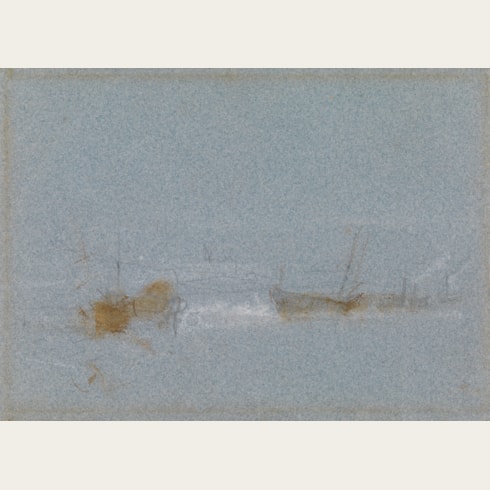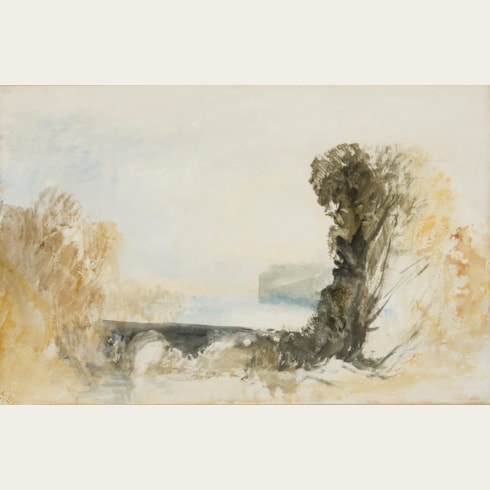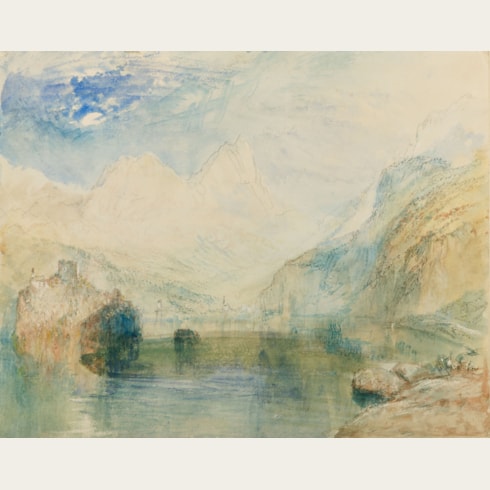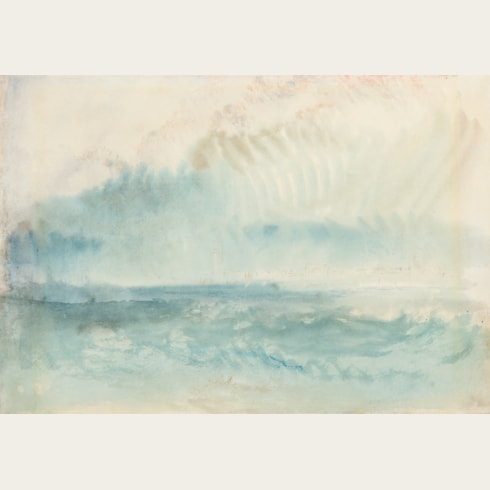Joseph Mallord William TURNER
(London 1775 - London 1851)
A Storm at Sea
Sold
Watercolour on white paper.
180 x 291 mm. (7 1/8 x 11 1/2 in.)
ACQUIRED BY THE MINNEAPOLIS INSTITUTE OF ARTS, MINNEAPOLIS, MINNESOTA.
In 1831 J. M. W. Turner made a visit to Scotland at the invitation of Sir Walter Scott, with the intention of making drawings to illustrate a new edition of Scott’s Poetical Works. During a period of several weeks in Scotland, Turner travelled extensively in the Highlands and the Isles. The present sheet may be tentatively dated to this period, and may be a first idea or ‘colour beginning’ for the sea and sky in Turner’s major painting Staffa, Fingal’s Cave, today in the collection of the Yale Center for British Art in New Haven, CT.
Turner visited Staffa – an uninhabited island in the Inner Hebrides in Scotland, dominated by a large sea cave known as Fingal’s Cave, formed of basalt columns - in August or September 1831, and the painting was exhibited at the Royal Academy the following year. Like the present watercolour, the painting depicts an arching storm cloud over a stormy sea. In the painting, the clouds are paralleled by the smoke from the funnel of a steamship at the right of the composition, and what may be a mast or funnel can just be seen as a vertical element above the waves near the left edge of the composition of this watercolour.
Turner’s late, ephemeral watercolours were an aspect of his working process that he kept very much to himself, and the present sheet is a rare example of one of these private works which seems to have left the artist’s studio in his lifetime or soon afterwards. (Although Turner produced numerous watercolours of this type, colour studies such as the present watercolour are only rarely found outside of the Turner Bequest at the Tate.)
A superb example of Turner’s remarkable gifts as a watercolourist, this expressive study of a storm at sea represents an aspect of the artist’s method that, as historian Richard Johns has noted, has only recently been studied; 'The private world of Turner’s sketchbooks and studio has been investigated, exposed and selectively called upon as evidence in the shifting assessment of the painter’s long-term significance for the history of art. This is nowhere more apparent than in those drawings and watercolours that are concerned with the sea.’
Born in Covent Garden in London, the son of a barber, J. M. W. Turner had little formal education. He entered the Royal Academy Schools at the age of fourteen, and exhibited his first watercolour at the RA soon afterwards, in 1790. Around 1794, along with Thomas Girtin, he began to visit the home of Dr. Thomas Monro and attend the informal academy there, copying drawings from Monro’s collection, notably works by John Robert Cozens. Turner was an inveterate traveler, visiting much of Britain in his youth and in later years making several trips to the Continent, notably to France, Italy and Switzerland. On his travels, he filled numerous small sketchbooks with rapidly-drawn pencil sketches. Possessed of an exceptional visual memory, the artist was able to translate these sketchbook studies into finished watercolours or oil paintings, sometimes many months or even years afterwards. By the 1830s Turner’s technical skill and bold sense of colour allowed him to achieve remarkable effects in his watercolours, and his late works in the medium, as well as his oil paintings, found a passionate champion in John Ruskin in his seminal five-volume book Modern Painters, published between 1843 and 1860. Turner produced some eight hundred designs for engravings, which, combined with a steady stream of patrons and clients for his works in watercolour and oil, earned the artist a substantial income. In later left he became something of a recluse, and had few close friends. The artist died of cholera at his home in Chelsea in December 1851, and the contents of his studio – around three hundred paintings and over 19,000 drawings and watercolours – were eventually acquired for the nation.
Provenance
Arthur James Balfour, 1st Earl of Balfour, Carlton Gardens, London and Whittingehame House, East Lothian
Thence by descent until 1986, when purchased by a private collector
Private collection, until 2008
Anonymous sale, London, Christie’s, 4 June 2008
W/S Fine Art, London.
Literature
J. R. Piggott, ‘Salesrooms Report’, Turner Society News, No.110, December 2008, pp.18-19; Sophie Barling, ‘Serious Pursuits’, The World of Interiors, August 2012, p.25; J. R. Piggott, ‘Salesrooms Report’, Turner Society News, No.118, Autumn 2012, p.35; Pieter van der Merwe, ‘Bonington and Turner off Boulogne’, Turner Society News, No.119, Spring 2013, p.16; Richard Johns, ‘Imagining the Sea’, in Christine Riding and Richard Johns, Turner and the Sea, exhibition catalogue, Greenwich and Salem, 2013-2014, p.211.








